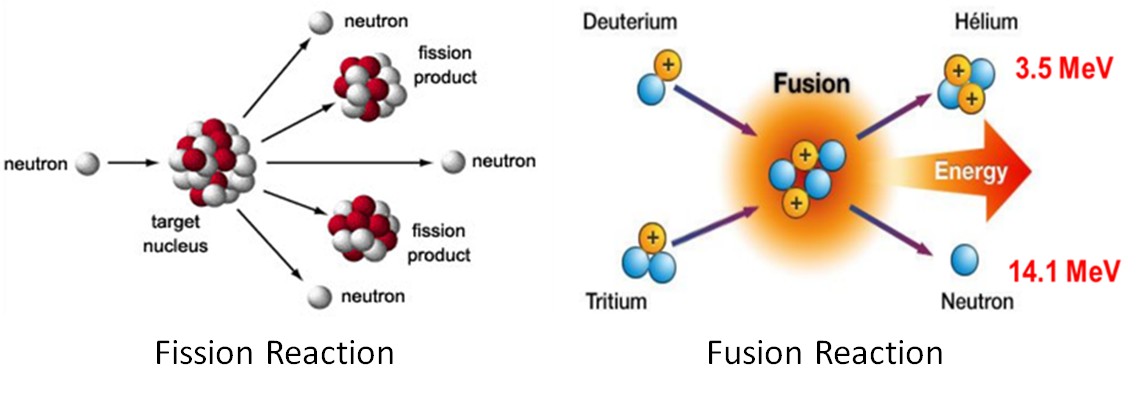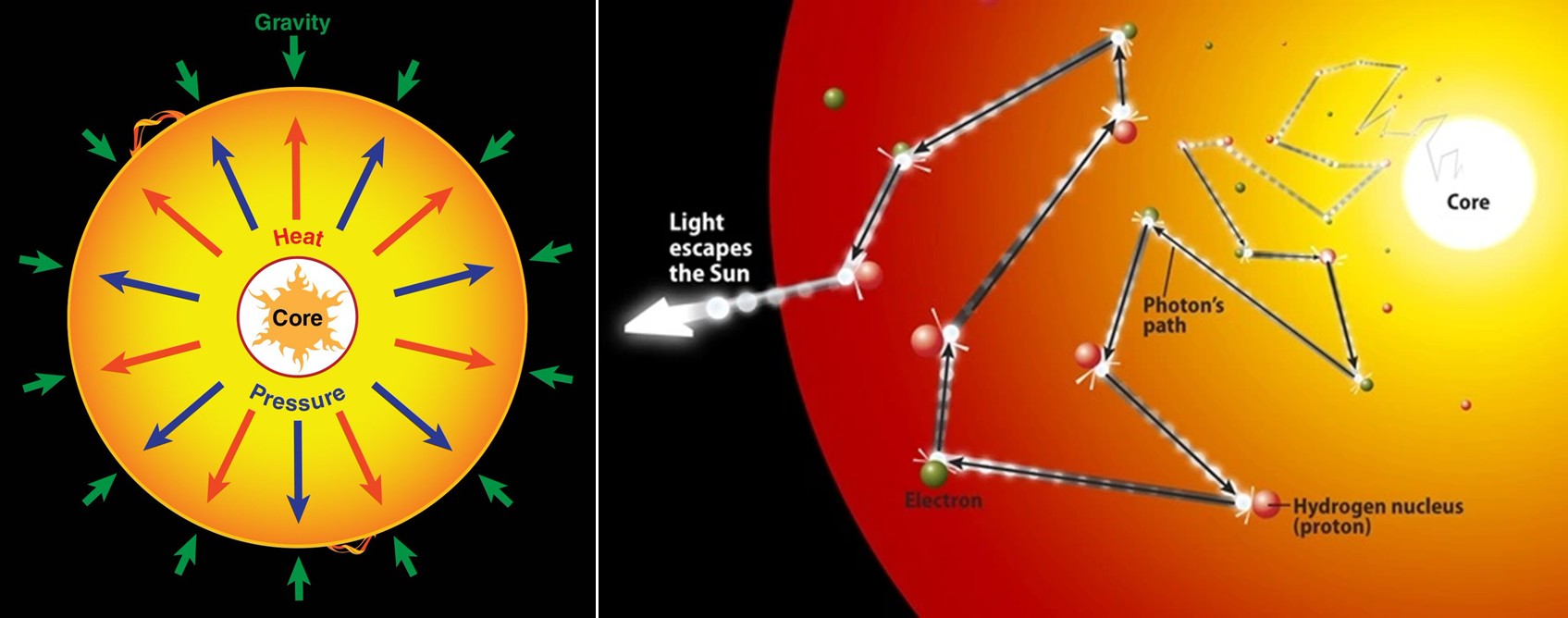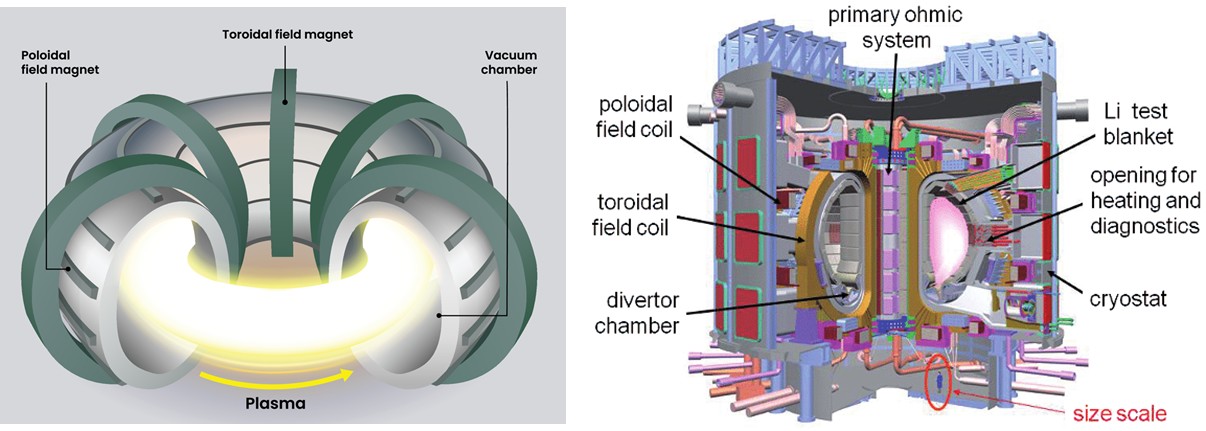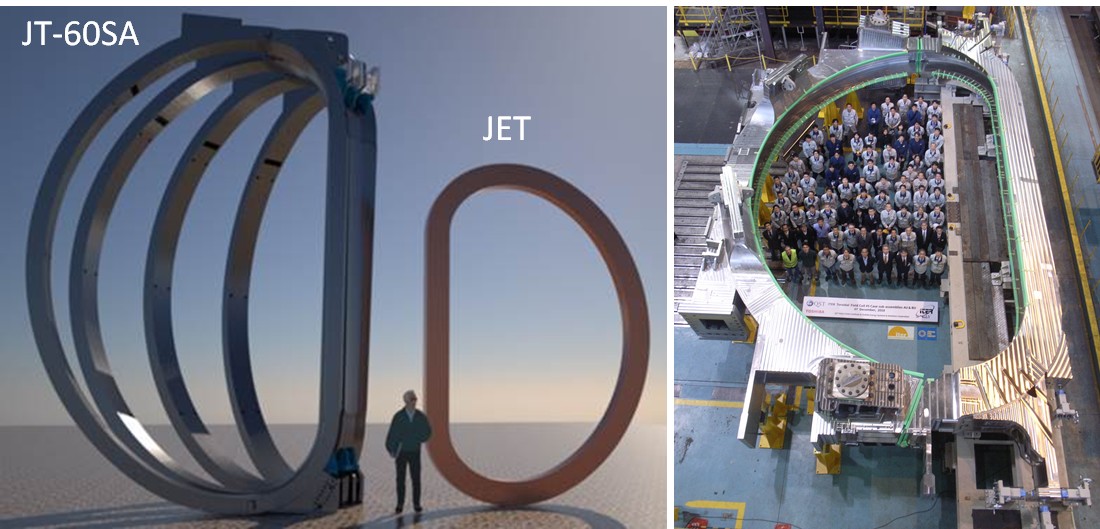Fusion
Nuclear Fusion & Tokamak
Nuclear fusion is a process where atoms are combined or fused together to release a tremendous amount of energy. It is the same process that powers the sun and other stars in the universe.
To understand fusion, let's first talk about atoms. Atoms are like tiny building blocks that make up everything around us. Each atom has a nucleus at its center, which is made up of positively charged particles called protons and uncharged particles called neutrons. Around the nucleus, there are negatively charged particles called electrons.
Like charges usually repel. However, in nuclear fusion, two atoms with light nuclei, usually isotopes of hydrogen, are brought very close together under extreme conditions of high temperature and pressure.When they come close enough, the strong forces within the atoms cause them to combine or fuse, forming a new, heavier atom. During this process, a small amount of the mass of the original atoms is converted into a large amount of energy (remember the famous equation E=mc2 ? ).
The release of energy in nuclear fusion is what makes it so exciting and promising as a potential energy source for the future. It has the potential to provide clean and abundant energy without creating a lot of harmful waste or greenhouse gas emissions, unlike other conventional sources like fossil fuels. Scientists and engineers are working on developing ways to harness fusion power effectively, although it's still remains a very challenging task.
Nuclear Fusion is where atoms are combined to release energy, as opposed to Nuclear Fission, where an atom is split into two smaller atoms. It occurs when a heavy atomic nucleus, like uranium or plutonium, is bombarded with a neutron. This collision causes the nucleus to become unstable, and it breaks apart into two smaller nuclei, releasing a large amount of energy in the process. This energy is what we harness in nuclear power plants and atomic bombs.
|
 |
Our Sun generates its energy through nuclear fusion. The Sun is like a giant ball of gas, mostly made up of hydrogen. In the center of the Sun, it's very hot and hydrogen is squished together really tightly. This creates a special environment where something called nuclear fusion happens.Specifically, it undergoes a type of fusion known as thermonuclear fusion, where hydrogen atoms combine to form helium.
Nuclear fusion is like when tiny particles come together to make bigger particles. In the case of the Sun, hydrogen atoms join together to make helium atoms. When two hydrogen atoms combine, they form a heavier atom called deuterium. When two deuterium atoms come together, they make a helium atom. Now, the special part is that when these atoms combine, they release a lot of energy in the form of light and heat. This is what makes the Sun shine so brightly!
Here's a step-by-step explanation of the fusion process occuring in the sun:
 The Sun is primarily composed of hydrogen gas. In its core, the temperature and pressure are incredibly high, creating an environment where nuclear fusion can occur. The Sun is primarily composed of hydrogen gas. In its core, the temperature and pressure are incredibly high, creating an environment where nuclear fusion can occur. The high temperature and pressure cause hydrogen atoms to collide with each other at high speeds. Occasionally, these collisions result in a process called the proton-proton chain reaction. The high temperature and pressure cause hydrogen atoms to collide with each other at high speeds. Occasionally, these collisions result in a process called the proton-proton chain reaction. The first step of the proton-proton chain involves the fusion of two hydrogen nuclei (protons) to form deuterium, a heavier isotope of hydrogen. This reaction releases a positron (a positively charged particle) and a neutrino. The first step of the proton-proton chain involves the fusion of two hydrogen nuclei (protons) to form deuterium, a heavier isotope of hydrogen. This reaction releases a positron (a positively charged particle) and a neutrino. In the next step, a proton combines with the deuterium nucleus, forming helium-3 (a helium isotope) and releasing a gamma ray. In the next step, a proton combines with the deuterium nucleus, forming helium-3 (a helium isotope) and releasing a gamma ray. Two helium-3 nuclei then fuse together, creating helium-4 and releasing two protons. Two helium-3 nuclei then fuse together, creating helium-4 and releasing two protons.The overall result of this fusion process is that four hydrogen nuclei combine to form one helium nucleus, while releasing energy in the form of gamma rays.
The released energy in the form of gamma rays moves outwards from the Sun's core through a process of radiation and convection.
As the energy reaches the Sun's outer layers, it is gradually converted into heat and light. This heat and light are what make the Sun shine and provide us with solar energy.
The Sun continuously undergoes this process of nuclear fusion, balancing the inward force of gravity with the outward pressure generated by the energy released during fusion. This balance sustains the Sun's energy output, and it is estimated that the Sun has been able to sustain this fusion process for about 4.6 billion years, with several billion more years to go before it exhausts its hydrogen fuel and undergoes significant changes in its lifecycle.
|
 |
(L) Comparison of density of hydrogen on earth and in sun's core (R) Repulsion of like charges and quantum tunnelling process
|
 |
As light photons and other radiation leave the sun's core, they run into electrons and atomic nuclei, scattering off each one. These interactions cause photons to take, on average, 200,000 years to move from the Sun’s core to its surface!
|
Our sun burns up nearly 600 million tons of hydrogen per second!
|
Nuclear fusion on Earth is a big scientific challenge because it requires extremely high temperatures and pressures, just like in the core of the Sun. Scientists are working on a special machine called a "fusion reactor" to make this happen. Since we do not have control on the gravity, we have to depend upon high temperatures to acheive fusion.
Several tehniques to acheive nuclar fusion have been experimented in the last 8 decades and currently the two most popular techniques are (1) To acheive fusion by magnetically confining hot plasma (2) To acheive fusion by inertial confinement using lasers. Of these two techniques, the magnetically confined fusion technique looks to be the most promising one.
One type of fusion reactor is called a "TOKAMAK". This term comes from a Russian acronym that stands for "toroidal chamber with magnetic coils" " It looks like a big donut-shaped chamber. Inside the tokamak, isotopes of hydrogen are heated to very high temperatures using strong magnetic fields, thus producing ht plasma containing ions and electrons.
When the ions of hydrogen atoms collide with each other at such high speeds, they can join together to make helium, just like in the Sun. This process releases a lot of energy in the form of heat.
But the challenge is to keep the plasma stable and hot (Tokamak plasma can get as hot as 150 million oC as compared to 15 million oC in the sun's core) for a long time so that the fusion reactions can keep happening. Scientists use strong magnetic fields to control the plasma and keep it from touching the walls of the chamber. This is called CONFINEMENT of the hot plasma and is acheived using strong magnetic fields.
The hope is that one day, scientists will be able to create a fusion reactor that can produce more energy from fusion than is needed to run it. This would be an amazing achievement because it could provide us with a nearly endless and clean source of energy, just like the Sun.
Many countries are working together on big fusion projects called ITER, which stands for International Thermonuclear Experimental Reactor. They are building a huge tokamak in France to try to achieve a sustained fusion reaction and learn more about how to make fusion energy a reality.
So, in simple terms, scientists are using special machines called fusion reactors to heat up hydrogen gas until it becomes plasma. Then, they control the plasma using magnetic fields and make the hydrogen atoms collide to create helium and release a lot of energy. It's like trying to recreate the Sun's energy-making process right here on Earth!
|
 |
(L) Simple depiction of magnetically confined plasma for fusion (R) The complex structure of ITER Tokamak
|
The expremely hot plasma cannot touch the walls of the tokamak as it will melt down the entire machine. To avoid this, strong magnets are used to confine the hot plasma to the centre of the vacuum chamber. These are acheoved using two major types of magnetic field coils i.e., the TOROIDAL FIELD (TF) and POLOIDAL FIELD (PF) coils. While the TF coils confine the plasma to the center of the vessel, the PF coils ensure that the lateral movement of the plasma is arrested. For holding the plasma for longer periods, these magnets are usually made of superconducting material, cooled using liquid helium (-269oC) at which temperatures, there is no loss due to I2R heating, so the high currents running through these coils can generate high magnetic fields for a long period.
Since these magnets generate a huge magnetic field, so the magnets and the vacuum vessel have to be secured using very robust support structures.
|
 |
(L) A comparison between the JT-60SA superconductive TF and copper TF coil of JET. (R) The TF coil of ITER .
|
For realizing fusion reaction on earth, there are several probable schemes. However, currently, the best combination of fuels will be Deuterium and Tritium, the two isotopes of Hydrogen. Each fusion reaction between D-T will generate a neutron carryinh 80% of the fusion energy (14.1 MeV) and a Helium atom (3.5 MeV). These high energy neutrons travel at 1/6th the speed of light.
While Deuterium is availiable in abundance in sea water. Every cubic metre of seawater will yeild 33 grams of Deuterium.
|
 |
The energy released by a fusion reaction is one million times larger than the energy released by a chemical reaction and 1 g of primary fusion fuel (deuterium and lithium) would deliver as much energy as 1 ton of coal.
|
D-T fusion neutrons travel at 1/6th the speed of light and can travel to moon in less than 8 seconds!
|
© IPR, 2023
Home IPR Outreach | Academic Visits | Comic Book | Exhibition Hall | Plasma Exhibition | People | Resource Materials | Science Day | Social Outreach | Solar Telescope | Training Program | TokoToy | Vigyan Samagam | 2022 Events | 2023 Events | 2024 Events | Upcoming Events | FAQ FAQ | Contact Contact | Ask A Question Ask A Question | Talk 2 Us Interact with a Plasma Scientist |
